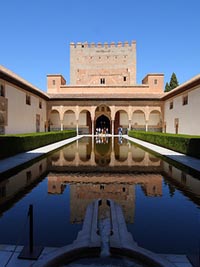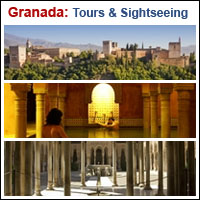 |
Spain | Travel | Regions | Cities | Coasts | Islands | Culture |
| Spain / Andalusia / Granada / Sightseeing / The Alhambra |
|
| More Information | ||
| Plan your Trip | ||
| ||||||

The Alhambra is not only the most important, but also the best conserved Arabian palace of its epoch. The name Alhambra means "the red one" and refers to the color of the mountain on which it is built. There are two entrance doors, in the north the Puerta de las Armas and in the south the Puerta de la Justicia. La AlcazabaThis impressive military fortification goes back to 9th century, and was modified by Muhammad III, in 13th century, to be his private residence. From the tower, Torre de la Vela, you have a great view over the town.The palaces of the Alhambra We start our visit with the palace of Mexuar,
We start our visit with the palace of Mexuar, The Palace of Comares, built under Muhammad V, is said to be the masterpiece of the Alhambra and was the king's residence. Its Ambassador's Room is the largest in all the complex. Its ceiling, a wonderful work made of cedar wood, represents the seven heavens of Islamic religion. The dimensions allow to have nine adjoining rooms worked into the walls, which are ornamented with epigraphs from the Koran. Another attraction is the palace's Patio de los Arrayanes The Palace of Muhammad V was the private residence of this Moorish king and is another highlight of the visit. Four great halls enclose the famous Patio de los Leones,  The Hall of the Mozárabes got its name after the Christian architects of the time of the reconquest from the Moors, which were themselves strongly influenced by Moorish style. In the case of this hall, they changed the original cupola for a baroque ceiling. The Hall of the Abencerrajes got its name from an Arabian noble family, who was murdered in here. In the King's Hall we find paintings of the Arabian royal family. For the reasons mentioned above scientists doubt if those paintings are original or were made, after the reconquest, by Christians. The most splendid hall is the Sala de las dos Hermanas,
The Hall of the Mozárabes got its name after the Christian architects of the time of the reconquest from the Moors, which were themselves strongly influenced by Moorish style. In the case of this hall, they changed the original cupola for a baroque ceiling. The Hall of the Abencerrajes got its name from an Arabian noble family, who was murdered in here. In the King's Hall we find paintings of the Arabian royal family. For the reasons mentioned above scientists doubt if those paintings are original or were made, after the reconquest, by Christians. The most splendid hall is the Sala de las dos Hermanas, Finally, we arrive to the Hall of the Ajimences and the Mirador de Daraxa, a view point, the view from which was obstructed lateron by the palace built by Charles V. The Alhambra after the reconquestThe Palace of Charles V,At the end of our tour we arrive to the Church of Santa Maria, at the place where before has been the Mosque of the Alhambra, and the Convent of San Francisco, built in 1495 over an Arabian prince's palace. Here were buried Spain's catholic kings up to 1521. The gardens of the Generalife Those marvelous gardens, bordering on the Alhambra, were made in early 14th century and conserve their original shaping. They inspired many important musicians and authors, among them Washington Irving ("Tales of the Alhambra"). |
 Note:
Note: